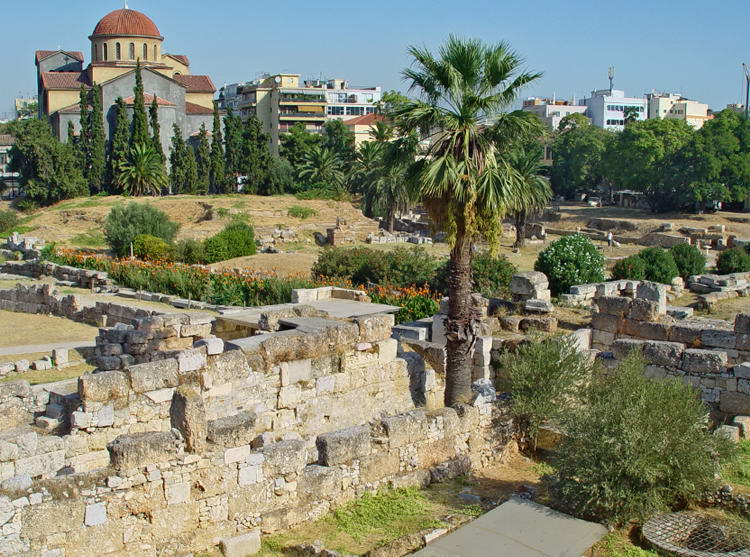Description
The archaeological site of the Kerameikos comprises part of the Themistoclean Wall, the Dipylon Gate and Sacred Gate, the Pompeion, the burial enclosure of the Stele of Hegeso, the Demosion Sema, and other well-known monuments. The entrance to the approximately eleven acre archaeological site is located on Ermou Street.
The Themistoclean wall was built hastily in 478 BC, after the Persian retreat, in order to protect the city from the Spartan threat. It surrounded the entire ancient city of Athens and divided the Kerameikos into two sections, inner and outer Kerameikos. Inner Kerameikos (inside the city walls) developed into a residential neighbourhood, whereas outer Kerameikos remained a cemetery. The section of the wall that crossed the Kerameikos in a N-S direction is preserved to this day, together with two important gates, the Dipylon, the largest and most formal Athenian gate, and the Sacred Gate.
Two important roads, the road leading to Plato's Academy and the Sacred Way (Iera Odos), which connected Athens with Eleusis, began at the Dipylon and Sacred Gate (Iera Pyli) respectively. The Sacred Gate was the starting point for the procession of the Eleusinian Mysteries, and the Dipylon the starting point of the Panathenaic procession, which moved along the Panathenaic Way towards the Acropolis. The preparations for the Panathenaic procession took place inside the Pompeion, a large building with peristyle court, located directly behind the wall, next to the Dipylon. The building dates from the end of the fifth century BC.
In the Classical period (fifth-fourth centuries BC) the streets were lined with cemeteries and funerary monuments, mostly of families and often decorated with reliefs. Some of the best-known funerary monuments are the Tomb of Dexileo, the Stele of Hegeso (c. 400 BC), the Relief of Demetria and Pamphile, and the marble bull from the funerary enclosure of Dionysios of Kollytos (c. 345 BC).
Outside the Dipylon, along the street leading to Plato's Academy, lay the Demosion Sema, or Public Cemetery, the burial place of Athenian notables and war heroes. This is where Pericles delivered his famous Funeral Oration for those who died during the first year of the Peloponnesian War (430 BC).
Working hours: 8.00-20.00
Tickets
Special ticket package: Full: €12, Reduced: €6
Valid for: Acropolis of Athens, Ancient Agora of Athens, Archaeological Museum of Kerameikos, Museum of the Ancient Agora, North slope of Acropolis, South Slope of Acropolis
The Themistoclean wall was built hastily in 478 BC, after the Persian retreat, in order to protect the city from the Spartan threat. It surrounded the entire ancient city of Athens and divided the Kerameikos into two sections, inner and outer Kerameikos. Inner Kerameikos (inside the city walls) developed into a residential neighbourhood, whereas outer Kerameikos remained a cemetery. The section of the wall that crossed the Kerameikos in a N-S direction is preserved to this day, together with two important gates, the Dipylon, the largest and most formal Athenian gate, and the Sacred Gate.
Two important roads, the road leading to Plato's Academy and the Sacred Way (Iera Odos), which connected Athens with Eleusis, began at the Dipylon and Sacred Gate (Iera Pyli) respectively. The Sacred Gate was the starting point for the procession of the Eleusinian Mysteries, and the Dipylon the starting point of the Panathenaic procession, which moved along the Panathenaic Way towards the Acropolis. The preparations for the Panathenaic procession took place inside the Pompeion, a large building with peristyle court, located directly behind the wall, next to the Dipylon. The building dates from the end of the fifth century BC.
In the Classical period (fifth-fourth centuries BC) the streets were lined with cemeteries and funerary monuments, mostly of families and often decorated with reliefs. Some of the best-known funerary monuments are the Tomb of Dexileo, the Stele of Hegeso (c. 400 BC), the Relief of Demetria and Pamphile, and the marble bull from the funerary enclosure of Dionysios of Kollytos (c. 345 BC).
Outside the Dipylon, along the street leading to Plato's Academy, lay the Demosion Sema, or Public Cemetery, the burial place of Athenian notables and war heroes. This is where Pericles delivered his famous Funeral Oration for those who died during the first year of the Peloponnesian War (430 BC).
Working hours: 8.00-20.00
Tickets
Special ticket package: Full: €12, Reduced: €6
Valid for: Acropolis of Athens, Ancient Agora of Athens, Archaeological Museum of Kerameikos, Museum of the Ancient Agora, North slope of Acropolis, South Slope of Acropolis
Published: 1 Jun. 2010
Add to favorite
- Information -
| (+30)-2103-463-552 |
| odysseus.culture.gr |
| GPS Coordinates |
| 37.978422 , 23.71761 |
| 37° 58' 42,3192"N , 23° 43' 3,3960"E |
Where to stay
accommodations located nearby
More Holiday Ideas
what else you can see here around
